Dungeons & Dragons Gazetteer by Rulebook Heavily
Introduction
Original SA post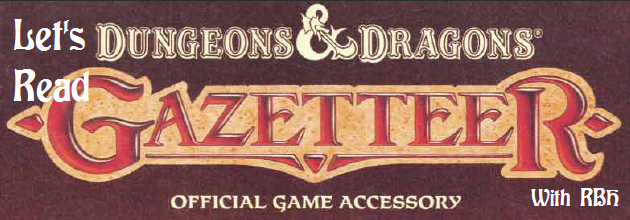
1. Introduction
I got completely stalled on Shadow Knight, and this has become The Summer of D&D Basic (especially with Evil Mastermind doing the Rules Cyclopedia), so instead...
What's a D&D Gazetteer?
This requires some context. In 1987, the Basic game of D&D (a.k.a. the BECMI line of products that ran alongside AD&D and would become the Rules Cyclopedia) had accumulated a sort of implied setting, originally called just "The D&D setting" or "The Known World", but we know it today as Mystara. At this point, however, it was just a couple of adventure locations, a mention of a city or two, and not much else.
The GAZ series (which ran for a total of fourteen supplements) were intended to add to what was there and create a fully realized setting in its own right. As Aaron Allston (who you might recall as an author of Star Wars licensed novels) puts it in the introduction to the first one:
quote:
One adventure might take place in Specularum, capital of the Grand Duchy of Karameikos, or in a lost northern valley of the same duchy. A series of adventures might take place in the exciting mercantile world of the Minrothad Guilds or the intriguing magocracy of the Principalities of Glantri. One epic scenario might bring war to all the known countries of the continent. And with each release, more is revealed about these settings... and the D&D game audience wants to know even more than that.
And that's why the GAZ series exists, by far my favorite line of D&D supplements to ever be produced and also quite possibly the most roundly ignored line of supplements by modern D&D. Even the Complete Book of Elves gets more attention and reprinted bits of rules and lore than this series combined. Outside the Gazetteers, Mystara only lives on as the setting of a handful of video games and scattered fan forums and incomplete wikis, and despite being the flagship setting of what is possibly the best-selling D&D product to ever be produced it's never been officially revisited. Today it's at best an obscure thing, confused with AD&D 2e more often than not.
That counts for this thread.
The Base Rules
The GAZ series had fairly strict oversight in terms of what they could and could not do. For instance, there would be no metaplot in the series. Subsequent products would not advance the "timeline" of the product line as a whole, but all be set in the default starting year, which is the first day of the thousandth year of the crowning of the first emperor of Thyatis (1000 AC, After Crowning). And if that tells you nothing, it'll get explained later. You might recognize this as the approach nominally used by the Exalted lines, with varying success: the GAZ series promises that all timelines will be "scrupulously checked against one another", which is at least promising. This was done so that people who didn't buy all the books would still be able to use them just fine and slot them into an existing campaign as they became available.
The second interesting thing about the series is that the books are very short. The first one clocks in at a mere 64 pages plus maps. This is to tie it in with the Basic rulebooks, which were all around that size. Imagine buying a setting-dedicated book today that was only 64 pages long! And third and most importantly, all of these books were designed to be easy to use by beginning players. The language is casual and informal, there's no overuse of purple prose (for the most part) and points are made quickly and efficiently. If only more products could do as much and writer's restraint wasn't just a notable feature of a single series of specialized products from the eighties and early nineties.
So how's this going to work?
I'm going to be reviewing all of these products. The settings, the alternate classes, the (surprisingly many) songs, the lot. I'll be doing it in order of publication, and I'm aiming for around four to five posts for each one. We'll see how well I keep to that. And it's going to take me a while as I have fourteen Gazetteers of up to 124 pages each to go through. Don't be surprised if I'm at it 'till Christmas.
I'll also be posting pictures. Lots and lots of hilarious and amazing pictures.
Next Time: GAZ1: The Grand Duchy of Karameikos
Gaz 1 Part 1: The Grand Duchy of Karameikos
Original SA post
2. Gaz 1, Part 1: The Grand Duchy of Karameikos
Let's start with the obvious part.
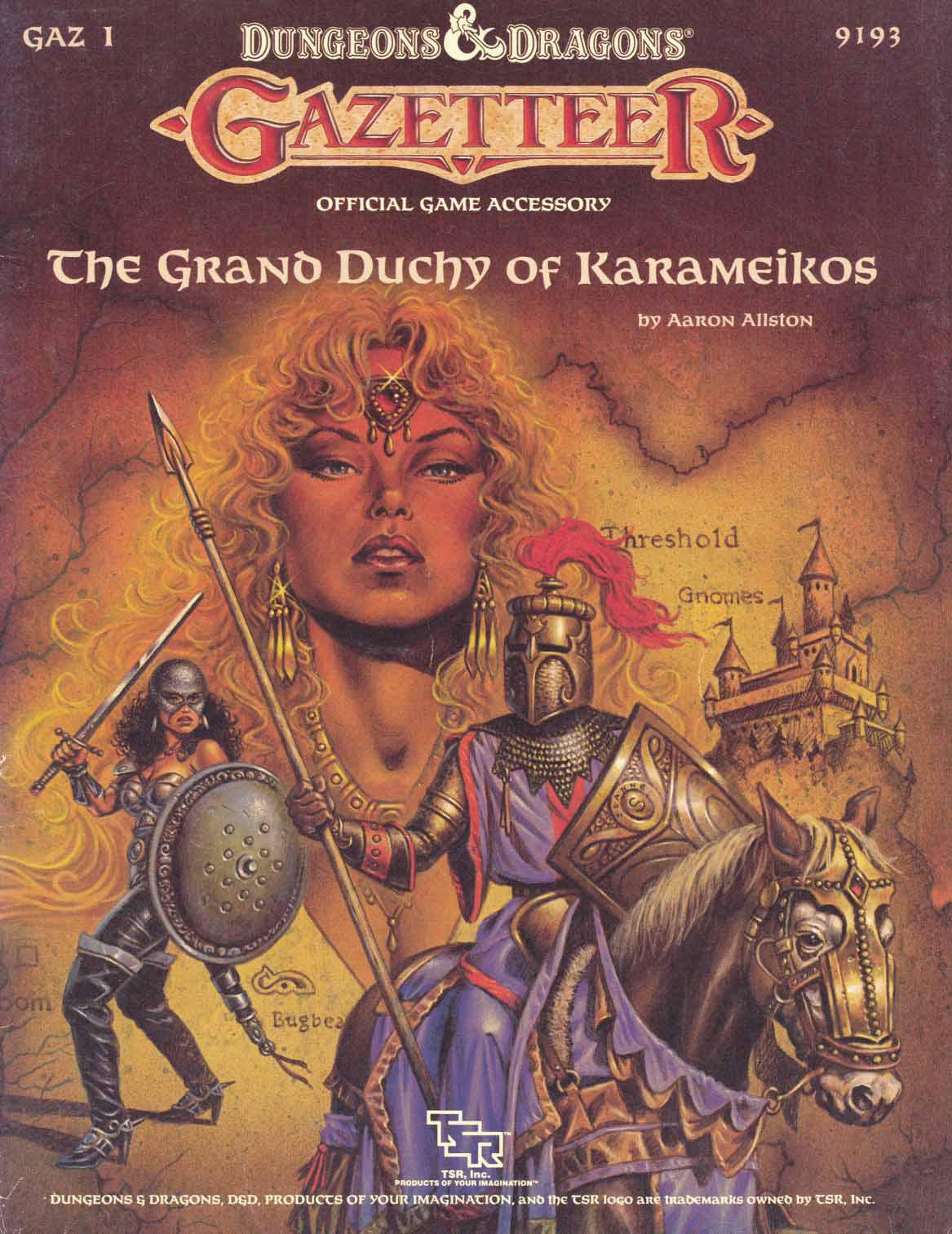
All fantasy novel covers used to be like this
It's a good looking enough cover, even with the whole She-nan the Boobplate Marauder thing going on there, but it doesn't really say much about the actual contents. This isn't that hard to understand, because they really were treading into new territory with this line and would be pretty unsure of it themselves while it was in production.
The book opens on a page-long introduction to the Gazetteer series, the D&D product line (as opposed to the AD&D one) and how to use the contents. That includes which sections you should give the players permission to read.
 Oh D&D. It also points you towards a section of published adventures that either take place in Karameikos or can be said to take place there, which I suppose is a kind of useful product plug. Then we're immediately on to business.
Oh D&D. It also points you towards a section of published adventures that either take place in Karameikos or can be said to take place there, which I suppose is a kind of useful product plug. Then we're immediately on to business.
The History of Karameikos
quote:
Let’s talk about what Karameikos is; what it
means to be from Karameikos; and how to
create a character from the grand duchy.
Short, sweet, to the point. I like it. It starts off with an overview of the history of the Grand Duchy, or rather of the history of the land it's occupying. As we'll see, the difference is rather important.
The most ancient piece of writing in the land is attributed to the Traldar people. They are the native population of Karameikos. It's unknown how old the actual poem is, but it was first written six centuries ago, and is titled "The Song of King Halav".
In short: There are people called the Traldar (later Traladara). They are totally the most awesome people of all and all the Immortals (gods) love them and bless them. They are beset by Beastmen (long extinct from the surface of Mystara), who have their own Immortals, and the Immortals go to war with one another. They are equally strong, so the war must be decided by mortals. The
 emote is going to apply a lot here.
emote is going to apply a lot here.
The Immortals descended to a village named Lavv, and find there three youths ready to receive their wisdom. Halav Red-Hair, a knive-knapper, learns the secrets of bronze, swordsmanship and warfare. Petra, a potter, learns archery, even more pottery, flax-weaving and spinning and medicine. Zirchev, a huntsman, is taught how to tame and ride horses and other animals and how to walk like a cat, swim as a fish and see like a hawk.
There was a king who was all "ha ha look at these fuckers" and tried to toss them out but Halav tossed him out on his ass, killed him with his new bronze sword and took over. He then married Petra and they ruled over the land (Zirchev stayed a Huntsman, keeping it real). This would turn out to be good because the Beastmen attacked, just as the Immortals had known they would.
quote:
The Traldar in their glittering bronze armor stood against them. The irresistible force of the beastmen crashed into the unmovable objects of the Traldar, and the war went on forever.
Goddamn .

Halav eventually found the beast-king on a hilltop and they decided to settle the matter in a duel in what was to be, quite literally, the final battle between men and beastmen on the surface of the Known World. No, really. All the beastmen disappear after this. In the end they kill each other, but the discipline of the Traldar lets them hold while the beastmen horde panics with the loss of its leader, and the day is won. Halav's rule is ever after known as the Golden Age of the Traldar.
Naturally, this is followed by a Dark Age. His empire splinters. Villages become distant. A curse settles on the land, and lycanthropes and vampires infest seemingly every forest and hill. This state of affairs would last until the last century, and technically most of the land is still a scattered mess of monster haunts and fearful villages. But trade won out on the coast, and the Traladara people (modern Traldar) did business with distant Thyatis and Minrothad and prospered for a bit. The inland Traladara grew apart from the coastal folk, culturally speaking, and are seen as ignorant and superstitious - but let's face it, they live in goddamn werewolf and vampire country. They've got a point.
Also there's "demihuman" tribes (the BECMI term for the various humanoid races); some inland Elves who apparently felt that settling in the middle of goddamn werewolf-infested nowhere was the proper thing, some Gnomes and Dwarves and Halflings to round out the playable races who are hanging about (more on them later), and that's one page done. Yes, really. They fit that into a single page. I've known gaming supplements that couldn't fit that into sixty-four.
Modern Traladara
Why are we talking about this Traladara place and not the advertised Karameikos? Because politics, that's why. The Traladaran coastal city of Maralinev prospered, and suddenly the neighbouring countries of Thyatis and Darokin realized there was this whole nation right there on their doorstep, becoming wealthier and more powerful. Darokin blinked first, and Thyatis swooped in and occupied Maralinev, renaming it "Specularum" because of how prettily the bay reflected the sunlight. Darokin accepted that this was Thyatian territory, Thyatis took some taxes and gave merchants even more access to their territory, and merchants grew even richer and more prosperous. Basically, no one really minded this arrangement, and the garrison was at best nominal. As far as the rest of Traladara was concerned, nothing had happened.
Until thirty years ago, that is, when a certain Duke Stefan Karameikos III requested that the land be awarded to him in exchange for complete autonomy from Thyatis. He brought with him some willing nobles, and set about ruling his new Grand Duchy. This has produced mixed results, with some fairly major mistakes made. The early settling Thyatians sometimes seized land without recompense from the Traladarans, who for the first time revolted against Thyatis. Stefan put a halt to that, but the damage was done and resentments still linger between native Karameikans and Thyatian Karameikans.
But that's the truth of the matter. Traladaran or Thyatian, they all now see themselves as distinctly Karameikan. Stefan had problems, but he successfully forged a national unity, at least for the time being. Whatever internal matters are left to be decided, a Karameikan will identify themselves as such when away from home and be proud to do so. Even so, there still remains a fairly vast portion of this Grand Duchy that has yet to be pulled under Stefan's rule, waiting for new nobility to stake their claims. (That's you, the player.)
The People
Traladarans tend to be smaller and lighter of build than Thyatians, with predominantly dark hair (with the occasional flaming red) and skin so pale it won't tan. Their culture is seen as superstitious, and it's true that a traditional Traladaran will see omens in everything around them. Outside the cities, most of them can't even read. But!
quote:
Player characters, being exceptional people, don't have to worry about this. If you have enough intelligence to be literate, you can be literate if you wish.
Yes, this is from 1987. This demonstrates in large part what it is that I still like about this series.
Traladarans are still disenfranchised and ill-represented among the nobility, and the Thyatian language is the official language of government, law and trade. The sad truth is that most Traladarans will simply be worse off than Thyatians. But here's an important tidbit.
You probably know how D&D has had a "common" tongue that everyone inexplicably speaks. Well, the GAZ series reveals how this is meant to be used. In Karameikos, Thyatian is the common tongue. It doesn't "replace" common, it is common in campaigns that take place in Karameikos. "Common" was always supposed to mean "common relative to your campaign's location". If the campaign later moves to Darokin or Glantri or wherever, the base tongue the character started with will still be Thyatian. Somewhere along the line, this got lost. Now you know!
Thyatians tend to be taller than Traladarans, with a much larger variety of hair colours and pale skin that tans easily. They also have the occasional redheads, including the Duke himself. It's not directly stated that this resemblance to the legendary king Halav helped the Duke, but it's not implausible! Many Thyatians are pretty much full-on White Man's Burden concerning the natives (though it's again mentioned your character can be more enlightened if you want that).
There's been relatively little mixing between these two peoples, mostly soldiers' sons from the old garrison. Because this is Ye Olden Times, they're called "half-breeds" by the book. Repeadetly. Yeah. They are said to have a pretty even perspective of both cultures, and they're not looked down upon by either, so in the end it's all moot.
The local Elves are kind of badass motherfuckers who willingly chose to settle among vampires and werewolves for the fuck of it. And it worked, too. They are of the Callarii tribe, something that won't be relevant much in this book but might be so later. They're otherwise pretty much classic D&D elves, all Aryan, slightly holier-than-thou, good and whatnot. Of note is that the Duke so earned their respect that he could establish a permanent guard unit of warrior elves, which incidentally gives them leeway in his court as well.
Gnomes are frontier traders who live in the foothills, far inland in Karameikos. Every year, they send out a big trade caravan to the coast along with their allies the Dwarves. They're fairly neutral towards human politics, but they like the Duke and his trade regulations.
Dwarves are very few in Karameikos, at most a thousand. They tend to either be of the local clan (itself a splinter of a larger clan) or foreign mercenaries or other professionals. They tend to be more favorably disposed to Thyatians and dismiss Traladarans as superstitious.
Halflings are almost all immigrants from the halfling territory of the Five Shires. They tend to be pretty much their own ethnicity, up to and including establishing halfling-only bars where they're the only ones who could fit comfortably in there. They tend to favor the company of the imaginative and poetic Traladarans and disdain Thyatian company.
Why yes, there's all kinds of racial tensions going on. How did you guess?
Shared Culture
Now I did say that the humans see themselves as Karameikan. This is not without reason. The Song of Halav is considered a shared national history now, and much like Arthurian legend it prophesies the return of the glorious king that will lead the nation to its destiny, etc. etc., and this kind of adventurous spirit has created a sense of unity and purpose. In addition, a local Traladaran custom called "the Shearing" is now shared by Thyatians.
Basically, when a youth reaches a certain age, they can approach their parents to be Sheared. They are given a cloak, and the hem of it is sheared away, giving the impression of a travelling mendicant. From that moment on, that youth is not family, but a friend of the family. They'll make their way in the world and then one day return with whatever they've learned, by which time they'll be accepted as family again. This applies to everyone, from the Duke's family downwards, and as we'll see it creates interesting character opportunities. The shearing is also technically optional for young women, but a lot of them take the option anyway so they won't just get married off.
All in all, a Karameikan comes off as infuriatingly confident in their own destiny and purpose in life. They make great adventurers and annoying tourists.
Next time: The Map, Character Creation and More History
Gaz 1 Part 2: Maps, Characters and More History of Karameikos
Original SA post
3. Gaz 1 Part 2: Maps, Characters and More History of Karameikos
quote:
Take out the colour map of Karameikos and
we'll give you a short course in the way the
Grand Duchy is laid out.
I just love these simple instructions, so let's do that!
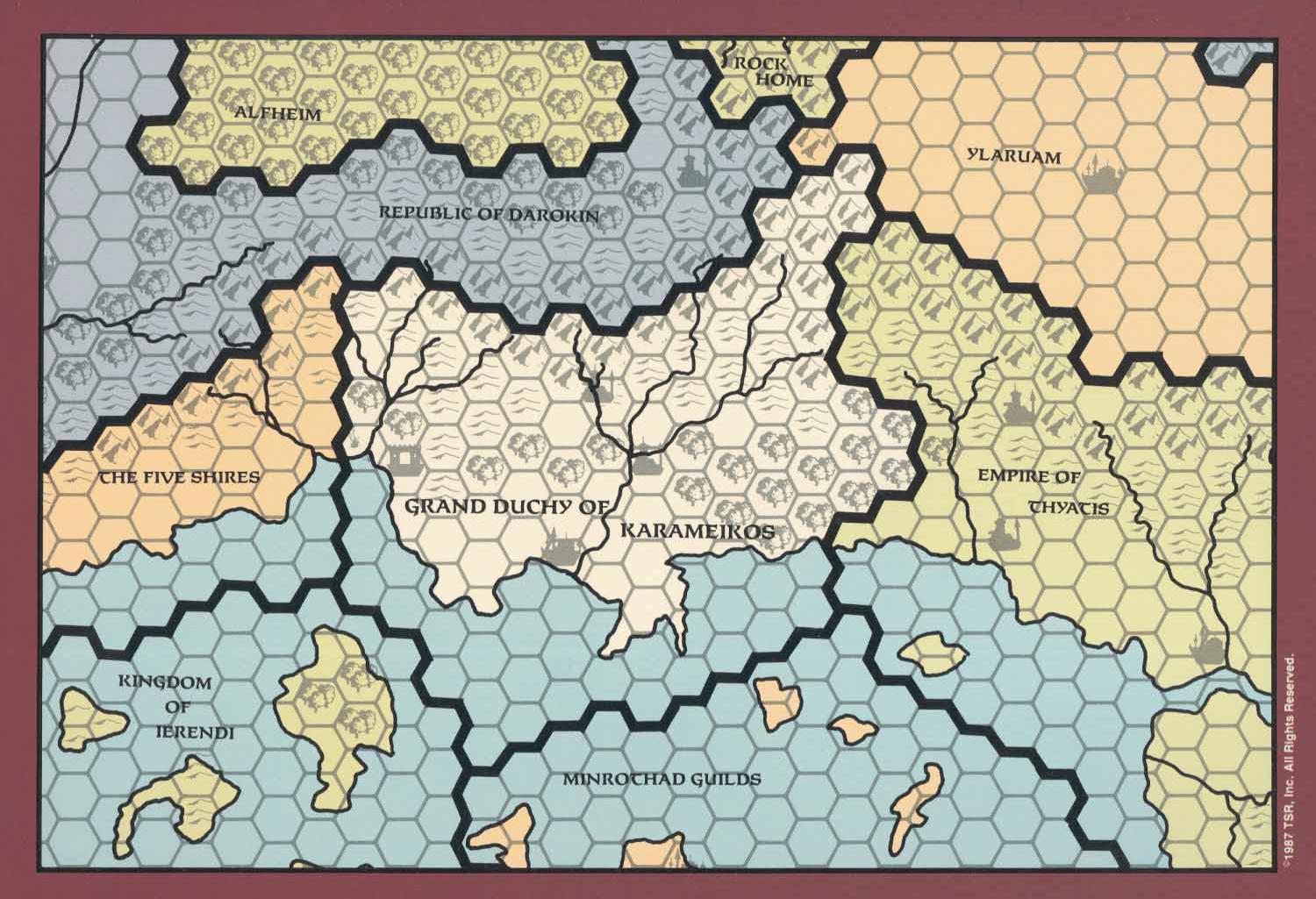
This is the more geopolitical of the maps, showing all the neighbouring countries in relation to Karameikos. And it also shows another thing that's worth mentioning about Basic and the GAZ series, namely that all maps are in hexes. Wilderness exploration rules and rules for governance tended to be focused on individual hexes, so they're a handy shorthand both for measuring travelling progress and for staking out a claim of your own.
Now for a more detailed map.
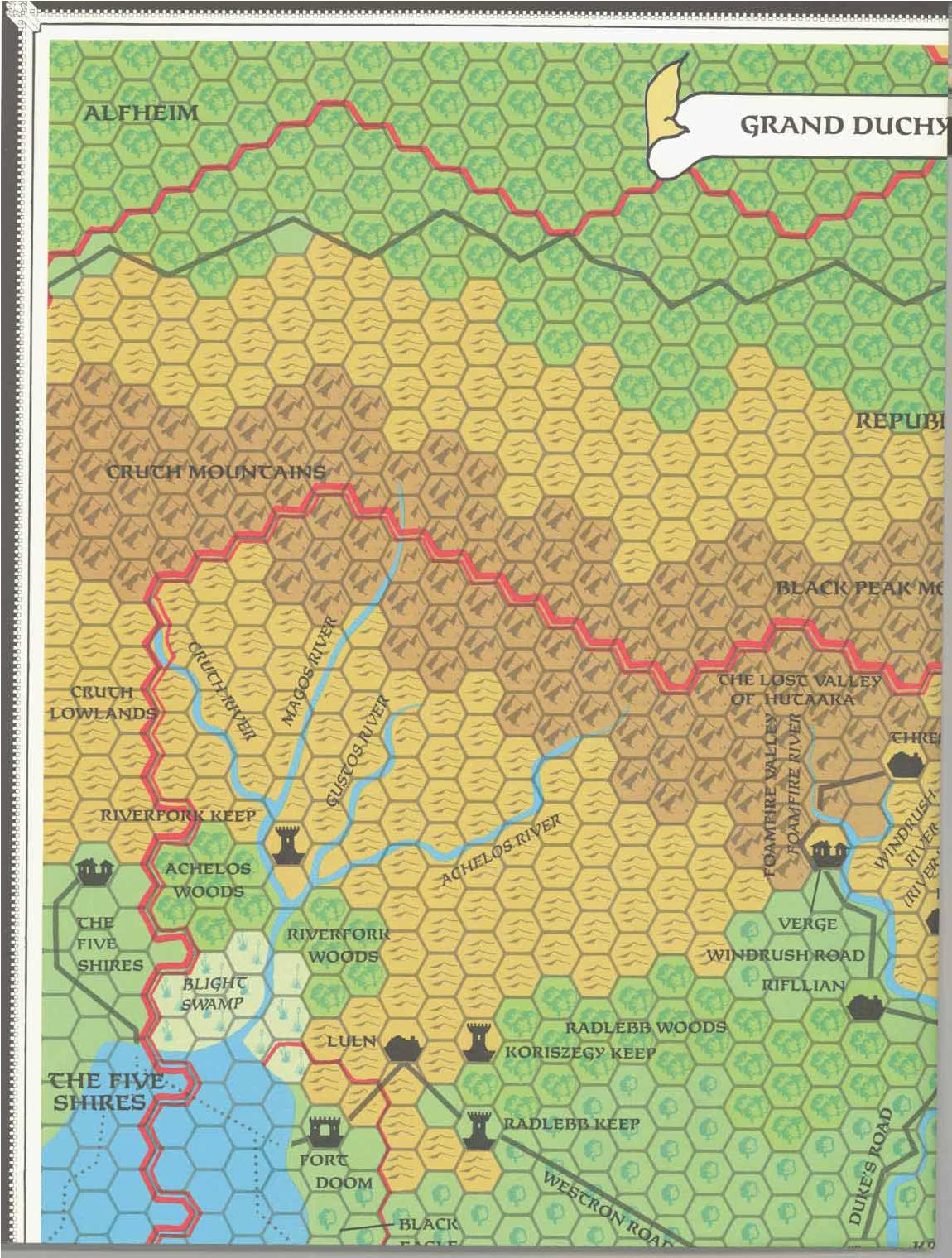
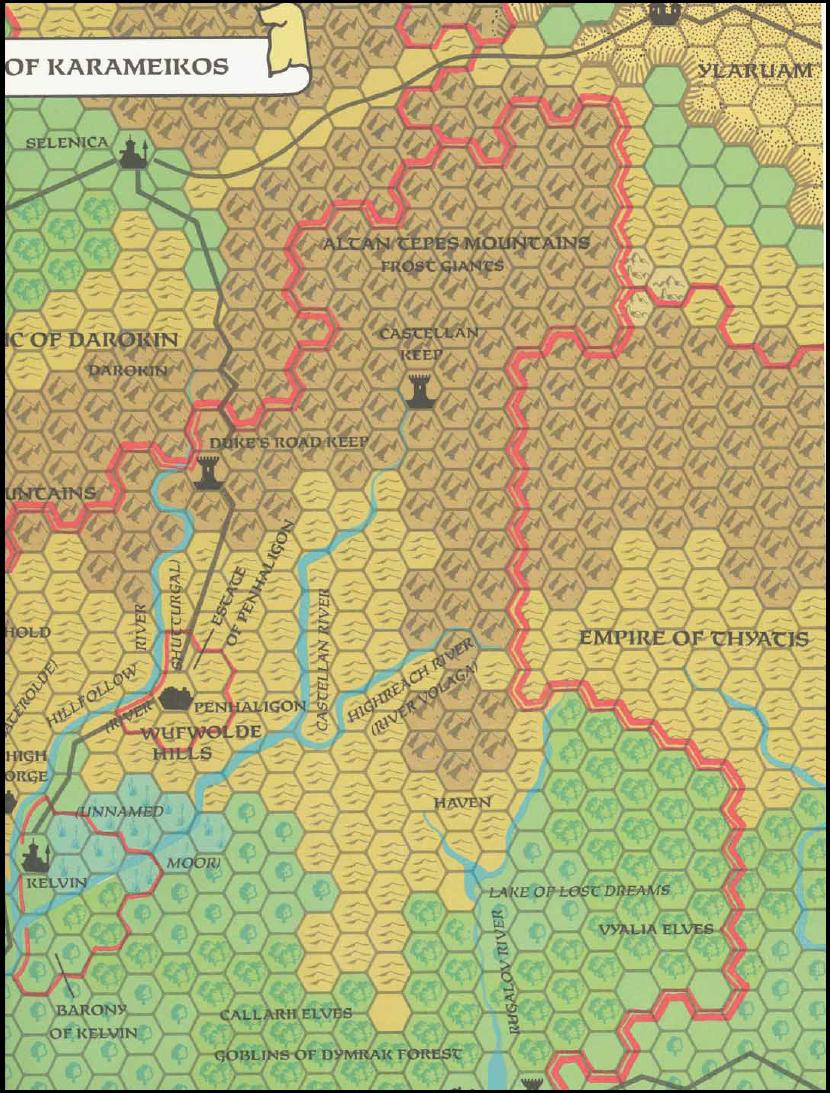
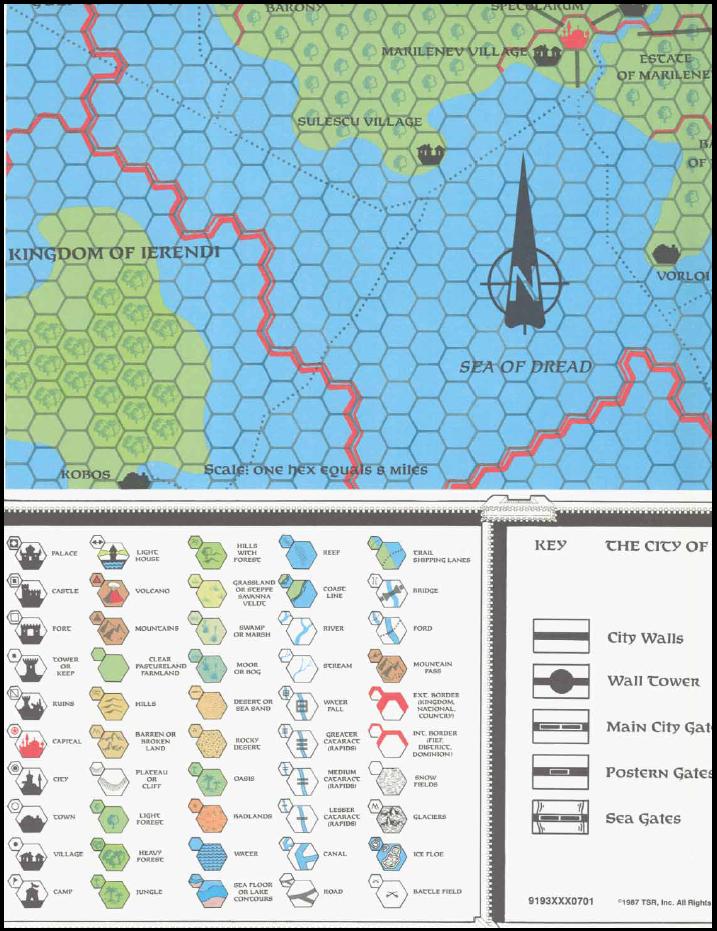
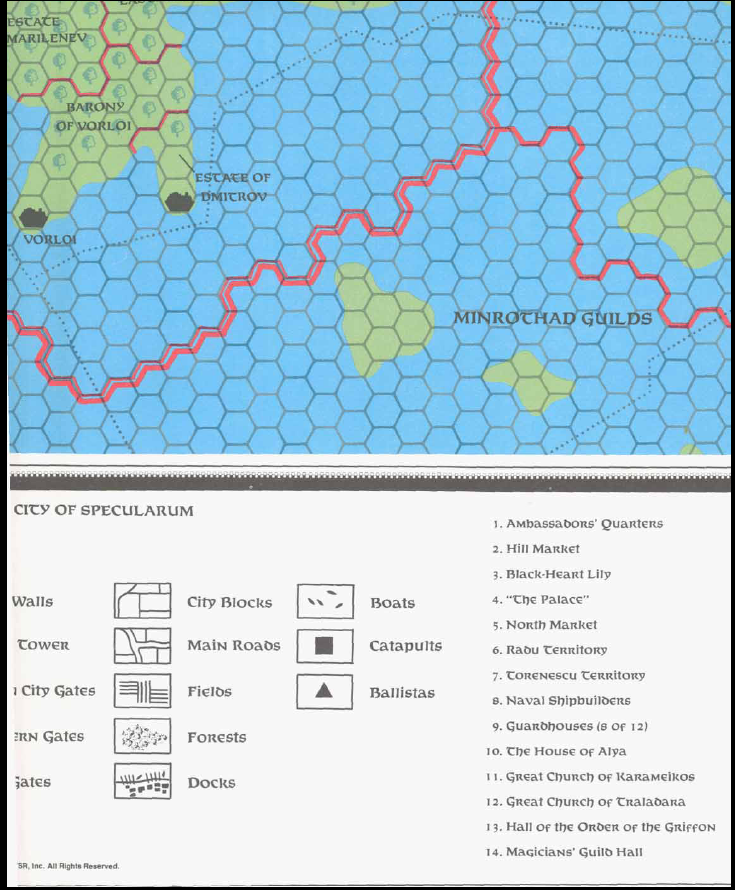
Yeah, you kind of have to piece these together. This is the map that shows the actual locations this part will talk about. It generally conforms to what was already explained: Large settlements on the coast and lots of wilderness. Some places have two names, one in Thyatian and one in Traladaran, just in case the local tensions hadn't been highlighted hard enough for you. The descriptions in this chapter are mostly meant for players so they can decide where their characters are from and to give them ideas.
Specularum is the capital, with about 50.000 inhabitants, ruled by the Duke and held tight by local merchant interest, largely the Radu, Vorloi and Torenescu clans. Those are names that will come up a bunch in the NPC chapter, mostly because they're all backstabbing each other.
Kelvin is the second largest "city" at 20.000, built at the meeting point of three rivers and the major landlocked traderoutes, and will thus see lots of traffic. It is well defended and is ruled by a Baron Kelvin II, who will also come up later. NPCs in this book aren't just mentioned and forgotten.
Krakatos is a ruin from the days of King Halav. No one lives here and you can't be from here, but it's a cultural landmark and is mentioned in the national epic. Guess it's here so players know it's important.
Luln introduces a very important concept in Karameikos, that being the Black Eagle Barony. Luln is made up of refugees from said Barony and its fortress, Fort Doom. Why yes, they are villains, how did you guess? It is ruled by one Mistress Sascia who is rumored to be seeking a noble title from Duke Stefan to better resist the Barony.
Threshold is a small logging community ruled by a Patriarch of the Church. Well, one of the two local churches. Did you think there would be no religious strife to go with the ethnic kind? It makes for an okay staging area for adventures.
Fort Doom was called Halag before it was invaded by Baron Ludwig von Hendriks, who is Duke Stephen Karameikos' cousin. He didn't have to invade or conquer the place: it was granted to him by the duke to rule. He just plain wanted to conquer some place and then rule it with an iron fist. Rumors of him kicking puppies for breakfast and stealing candy from children are as yet unconfirmed. He rules around 10.000 people from his fort, and the Duke either can't or won't move against his cousin, so they get to be miserable.
Highforge is a Gnome community of 6500 with an additional 1000 dwarves living there as well. That's literally all there is to say.
The Callarii lands have no accurate census because elves don't give a fuck and humans can't keep up. They're still estimated at around 7500, scattered in small family/tribal communities of up to 200 each.
There's a note on the general character of smaller communities (tiny, fragile, given to superstition) and then the chapter moves on. All in all, it's a good selection of potential plot places, home towns and misc information. So now we have a bit of the national character, the local ethnicities, the local languages and a bunch of hometowns. Time to use that information.
Character Creation in Karameikos
In case rolling 3d6 in order isn't random enough for you, you can randomly roll for your background in Karameikos. It's optional, but neat.
It begins with you randomly rolling for your starting social standing. This won't actually affect anything but your backstory, so it's just a neat thing to do. It ranges from abject poverty at 1 to immense wealth at 90+. If you roll 100, your character is actually a member of the royal family, possibly even a daughter or son of the Duke! And this isn't treated as untouchable NPC territory, just as the opportunity for plot hooks it is.
Social Status doesn't actually change any of your stats at all, not even your starting wealth. The Shearing Ceremony (which PCs are generally assumed to be undergoing) cuts ties with the family anyway, so what you get instead is explanations for what your Starting Wealth represents. If your family is poor, it represents a lifetime of savings carefully hoarded for this day. If it's wealthy, the money is just a tiny stipend to see you on your way. It also gives you different motivations for trying to succeed, whether that's being the youngest daughter of a rich family making her own way so she won't just be married off to someone or the son of an immensely poor family looking to improve their lot.
Once that's done, you can randomly determine your ethnicity (if Human). You're Traladaran if you roll 1-70, Mixed if you roll 71-90 and Thyatian if you get 91+. And here's a little Gygaxian Naturalism for you: You add half the score you got when rolling for social status to this percentage roll. Yes, this does mean that you're more likely to be Thyatian the higher your social status is because Thyatians are economically privileged in Karameikos. Verisimilitude and all that.
Finally, you can randomly roll for your home town. That can include the Black Eagle Barony, though that's much less likely if you're a Cleric, Wizard or wealthy, all three of which are tightly controlled by Von
I do like this little minigame because what this system does isn't about simulating some fantasy reality or rewarding some players for rolling good, but to provide you with generous plot hooks. Every step of social status combined with ethnicity provides you with extant social ties, potential motivations and goals and even pre-packaged ethnic tensions. Using this system, you'll get a character that's more interesting than just "I am Jim(m) The Fighter", tied into the setting presented in the book. Plus it's made clear that you're free to just use it for inspiration and ignore rolling altogether if that strikes your fancy, and the frequent trading vessels mean you can even play something completely foreign to the setting with no difficulty fitting into the campaign.
There's a separate table for the various non-human races, and then there's names. Thyatian names tend to be Byzantine-inspired or classical Roman, while Traladaran tend towards central and eastern European. Mystara does this a lot, actually: you can pretty much assume that the culture of each is directly lifted from those sources too. It's best to just roll with it.
There's also a special note on Magic Users, namely that the local art of wizardry isn't exactly well researched or advanced, so there's a fairly limited list of what spells Magic-Using PCs can easily learn from the local Guild. After Third level spells, the list is sharply reduced to just a few per level, and none above seventh. I'm guessing this is meant to encourage adventures, but it's also an example of how Basic expected DMs to adjust spell lists to suit the needs of campaigns (and play balance, for that matter).
There's also a section on skills. They're not that interesting. They are basically non-weapon proficiencies from AD&D with advice attached (like "everyone should try to have Ride unless they want to fall off horses when in danger").
Even More History
Because this is the eighties, there's a Totally Secret DM History. What we already know is stuff that's common knowledge and is supported by the available evidence and texts; technology did just seemingly appear at a certain time among the Traldar, just as the legend says. But DMs get to know what actually happened!
I'm not sure how that's very useful, because none of it is all that interesting except in a general "we're trying to make this myth more realistic" kind of intellectually wanky way. But basically: The first Traldar were settlers from a land call Nithia, around 1500 BC (2500 years ago in the setting). Think sort-of-egypt. They lost all ties with home and essentually just tried to survive. However, they were contacted by jackal-headed humanoids called the Huutaka, named for a mountain north of Karameikos. The Huutaka wished to aid the Traldar, so they sold their technology for food, work and slaves. Yay, pre-modern morality. They eventually came to dominate Traldar culture.
Around 1000 BC, this arrangement was upset by a mass invasion of Gnolls. The Huutakan High Priest ordered in the name of their God, Pflarr (bless you), that all Huutaka were to retreat and take their shit with them while the humans held the Gnolls off and died. And the three figures of legend were real, although Halav was already a king when the invasion occurred, Petra was herself a queen of a different tribe of Traldar and a widow, and Zirchew was actually an educated man who studied with the Huuraka (hence legends painting him with a bestial aspect). And then they won the war, Gnolls retreated, history marched on.
So that explains the sudden technological ascension of the Traldar: some other guys came and taught them all that shit. And since the Huutaka betrayed the Traldar, they got lumped in with the Gnolls into one "beastman" in the legend and then forgotten. Without Huutaka knowledge, they couldn't easily maintain a large kingdom (no bureaucracy left to speak of) and hence the Dark Age happened. After that, things proceed as already told until Stefan shows up.
Here's a detail that wasn't in the player's chapter: There's a reason why an indipendent territory is called a "Duchy", because Karameikos wanted to give the impression that the Thyatian armies would defend them if attacked. He's less inspiring and more canny in this account. There also used to be a Maralinev clan of traders (in the city of Maralinev!), but they got wiped out during a brief but bloody rebellion against the Duke when he came to take over. The other power players, the Radu and Torenescu clans, haven't forgotten this, and the Duke keeps careful watch on them. He's fended off assassins a couple of times.
There was also the problem of populating the place with loyal nobility. Karameikos invited the younger sons of nobility from Thyatis, including the first Baron Kelvin, but also including his cousing Ludwig Von Hendriks. He's tied himself into a knot with that one, unable to deal with Von Hendriks for good or even to understand the man. Worse still, Von Hendriks spearheaded the move to seize land from the locals at spearpoint, which created the lasting tensions that the Duke is still dealing with. The Duke was too busy and too thinly stretched dealing with the Black Eagle's imitators to deal with him in time.
Since then, the Duke has taken a pretty chill approach to ruling. He prefers to hire local experts to deal with issues, which has fostered a reputation for fairness among the Traladarans, and his charisma alone has managed to foster some kind of unity out of this mess. He is married to a distant cousin of the Thyatian emperor, and they have three children (unless Players note otherwise). I'm not sure why his curriculum vitae needed to be a DM only affair, but eh.
Verdict: Ehn. I guess it's a plot hook to find the Huutaka or evidence of them, but this chapter spends a lot of space restating things that were already said and then adds very little. I personally think the myth would have been enough, especially since there's no actual advice on having the players ever find this stuff out. Common for its time, but annoying nonetheless.
Let's finish this with a Timeline. Note the invitation to carefully check this against other timelines published in later Gazetteers for maximum accuracy, the retcon of a previously published adventure to take place 200 years after the current year (it's essentially a fantasy World War scenario) and also how the OD&D Blackmoor setting happens 3000 years before the current time. Complete with its ray guns and crashed spaceships. Ohh yes, that's going to be relevant in upcoming books.

Next: Politics, Culture and Completely Useless Economics
Gaz 1 Part 3: Politics, Culture and (almost) Completely Useless Economics
Original SA post
4. Gaz 1 Part 3: Politics, Culture and (almost) Completely Useless Economics
quote:
This isn't a section on the way that politics are
supposed to work in an ideal Karameikos. It's
ascction on how they DO work, and how they
can affect player-characters and their adventures.
Take note, game designers. This is how you use mundane detail to create useful things for actual play.
This section is fairly long and detailed, covering the political powers inherent in the Ducal title (notably the power of the Duchy is shared equally among husband and wife) and details surrounding them. Since players in Basic are expected to settle down at some point, there's naturally a system of titles they can earn from the Duke for exemplary service. There are six ranks under the Duke: Court Lord, Landed Lord, Knight, Landed Knight and Baron.
There are equivalent military and religious ranks, though they never surpass Knights in prestige. Priests only have three, for instance: Priest, Bishop and Patriarch. Wizards, being lone weirdoes, generally don't get no stinking respect. Who do they think they are, fighters?
But this doesn't tell nearly the whole story. The nobility are just one pillar of power in Karameikos. A great deal of power rests with the big Traladaran clans, whose total monopolies were broken by the Duke thirty years previous. The old Maralinev clan (after whom the city was originally named) has thrown itself behind the Torenescu clan, and thus has the support of a large population of farmers and freemen. The head of the Radu clan is the master of the merchant's guild. Between these three (and more), the Duke has plenty to contend with. There is also the military, commanded by Admiral Hyraksos, who is unfailingly loyal to the Duke... but is looking for a successor. And if that successor is not as loyal, bad things could happen. It could even be you.
And then comes one of my favorite things in the book: they demonstrate the push and pull of Karameikan politics and legal power by showing a sample case going through the system. It's essentially a complete adventure you can even run you players through.
Davinos' Complaint
A young Traladaran man named Davinos seeks the Duke's ear for several weeks and finally gets it. He presents the complain that lands were seized from Traladarans by a certain minority of Thyatians, and the Traladarans in question should be allowed to pay lower taxes for a period of years as compensation. Duke Stefan takes it under consideration. The player characters can get involved on the next day when a bunch of Thyatian thugs attempt to beat the shit out of Davinos, telling him he's a Traladaran dog who should be content with his given bone. Ouch.
But it gets stranger. Anton Radu, head of the Radu clan and the Merchant's Guild, is also the leader of a crime syndicate called the Veiled Society. He uses his network to spread Davinos' story, except in this version Duke Stefan laughs at him and has him tossed out. When the people are sufficiently riled, Anton executes his plan: have some Society thugs murder Davinos on a street near the Ducal palace by luring him there with a fake messenger. After this is done, a "respectable" businessman hires a mixed adventurer group of Traladarans and Thyatians (The players) to help prevent this. They "just happen" to arrive in time to see the deed done. There's resentment. A couple of Thyatian businesses go up in flames (with maybe the players around to help save lives). It's the topic on the street.
Then the players are approached by a local poet and playwright, Emilio the Great. He is secretly part of the Duchess' spy network. Since the players are by now well known and regarded in Specularum (even the Thyatian members) for trying to save Davinos, Emilio judges them trustworthy enough to discover the truth behind this matter. And it's a matter of time now, because the rioting is getting uglier and now the demand on the street is reduced taxes for all Traladaran merchants, something the Duchy simply can't afford to do.
The players are supposed to discover that the identity of the fake messenger who led Davinos to his death is inconsistenty described. Suspicious! The section gives you a selection of appropriate NPCs from the NPC section of the book who can reliably identify the "messenger" should they see him again. The players then capture the messenger (climactic fight suggested) and reveal the truth: A Traladaran of the Veiled Society had Davinos killed. Eventually the riots will calm. the Duke and Duchess now know the players by name, and so does Anton Radu, who will keep a closer watch on them from now on.
quote:
This is how dry Karameikan politics becomes exciting Karameikan adventures. Remember: the only purpose of politics in this game is to set up interesting encounters and activities in which the player characters can participate.
There you have it! The section segues smoothly into describing crime in the duchy, from the Veiled Society (essentially thugs and mafiosos who prey on disenfranchised Traladarans) to a slavery ring called the Iron Ring. Yes, it's ultimately run in the Black Barony. You didn't think the Black Baron was content with just being a dick at home, did you? He outright sells his own people as slaves, and then steals people from other nobles too. There's also a nobler band of non-finger breaking, non-slaving, non-mafioso thieves called The Kingdom of Thieves, led by a certain mysterious person named Flameflicker. They only rob the rich, and only rarely, but every single robbery becomes notorious for its audacity and execution.
Explanations of Courtly Ranks
These are interesting mostly for what they allow players to do. Players are considered Freemen by default, who are just ordinary citizens. They might then be given the title of Court Lord/Lady, which confers no lands or responsibilities but is more a recognition of service to some noble or other. Squires (the assistants of Knights) earn this automatically, and soldiers of at least Lieutenant rank and Priests get treated as Court Lords/Ladies. Even though it's just a title, it means that your character is nobility and will be treated as such by other nobles and freemen, usually meaning more respectful treatment. It's not hereditary, and does not benefit the recipient's family. Any player character can earn this title.
Most of the other titles are reserved for Fighters, because Fighters are fucking awesome. The rank above Court Lord is Landed Lord, and to be landed you have to be specifically given a Fief by the Duke or Duchess, not just by having seized some wilderness fortress. (Though if you do, the Duke might award it to you anyway in recognition.) Your spouse earns the same rank as you, and your heirs receive the fief on your death. That comes with the responsibility to manage and defend the fief, but fortunately the Rules Cyclopedia has an entire system to deal with that sort of thing. You're expected to earn a title like this at level 9 or thereabouts as a Fighter, assuming you want to, called "Name Level". The clerical and soldiery equivalents are Bishop and Captain, though they don't come with land.
Above this is Knight. Knights are something of a special case in that they don't have to be Landed. Their spouses, children and squires are automatically considered Court Lords and Ladies. Here's where the social rules start getting really interesting, too! Knights never have to obey weapon restriction laws. They can demand and expect to receive one night's shelter from anyone, even the Duke. Knights are obliged to get adventure hooks on a regular basis. No, really. A Patriarch of the church and the grand commanders of the Armies are considered equal to Knights, and there's technically nothing that says that non-Fighters can't be knights. Then comes the Landed Knight. Now you're a real bigwig with a crib.
The final rank a player can expect to earn (normally...) is Baron. You need to have been a landed Knight "for five experience levels" before you're considered for this, which provokes all kinds of totally ignored questions. Barony isn't automatically transferred to children, technically speaking: it must be confirmed officially by the Duke. And at this point, your land probably covers several hexes on the hexmap rather than just one or two, maybe seven or more. And the Black Baron has to treat you as an equal, so good luck being on his shitlist. There also exists the Duke title, but again you technically don't earn that normally. You'll have to be devious or an heir or both.
Absent from this system are Slaves (illegal in Karameikos because Stefan don't like that shit, not that Von Doom cares) and Counts, because they're not currently required what with the low population and actual amount of pacified land to go around.. Stefan also doesn't call himself a King, although he technically is one. He wants to actually earn the rank first by properly pacifying and defending the entire country first. Nice dude! So how do players climb these ranks? Well, they can start as Court Lords for one, depending on their choice or roll during chargen. As for other players...
quote:
If you can, try to grant the first player character his award of court lordship when he doesn't expect it.
If your players are just jockeying for awards, the noblemen will spot your slimy selves and not award you anything. It should be a reward for a deed done, not an expectation. Fair enough, I guess, although it's a bit heavy handed. After that come guidelines on who becomes a Knight (fighters probably, Dwarves and Elves sure, Thieves unlikely, Magic Users - haha no). The game doesn't restrict any character class from becoming Landed or a Baron, but it's only really an expected thing specifically for Fighters.
Also, there is currently no non-human landed nobility in Karameikos. The various races have their own ranks, but the Duke doesn't intrude on them and they don't ask for his permission. They have their own rules of domains (generally involving artifacts and families more than lands), but they can become landed instead. Karameikos is permissive that way!
Advancing up through the ranks is generally timed by "glorious adventures", which I like. You do stuff like win a war or slay a mighty ravaging dragon who lays waste to the Duke's lands and you gain a bigger title. And then comes a special section of how a character might usurp the throne and become Duke! They could be a legal heir and kill all the others (or just be the oldest and wait), they could marry into the family (the kids prize love over politics and won't give a shit about any arranged stuff - this is the frontier, not Thyatia!), they could rise in glorious revolt and take over (a good idea for a Chaotic party), and similar. This setting does not give a shit about preserving its uberpowerful NPC status quo, as you'll quickly learn.
Those non-Fighter types
There are special notes for Thieves and Clerics: there's no reason why they can't be landed. There's an example of a landed Cleric in Threshold already, and Thieves could just, y'know, not be Guild thieves. No prob. Duke's chill with it.
The Churches are also pretty chill, as they don't actually worship any Gods and/or Immortals directly (though some Immortals are clearly granting them spells). The Church of Karameikos is generally about being a cool, good dude who doesn't do bad (Lawful), deals a great deal with matters of marriage, and has a special note that superstition is stupid and wrong and you shouldn't do it. But it's not the only Church. There is also the Church of Traladara, older than the Karameikan one. It takes a more corporal approach to punishment for sins, considers the cleric's personal approach to wisdom to be more important than Law, doesn't perform marriages or interfere in relationships, considers superstition to be a natural expression of curiosity about the world and, oh yes, the Song of Halav is literally true and King Halav will one day return to lead Karameikos to glory. 70% of all Karameikans belong to this one, but most of the Thyatian population prefers the church of Karameikos. Oh dear.
And then... there's the Cult of Halav. They believe that Halav died and that his spirit was taken away by the Immortals to rest and heal: That Halav's return has come: And that Duke Stefan is, in fact, King Halav reborn, and that Stefan will unite the land and then go on to conquer the entire world. And even though they are considered completely nuts, some Immortal seems to be granting them power. Commoners are ambivalent about the cult, but the Clerical orders are more interested in the theological question they pose.
The final option provided for Clergy is for Fighters to join a religious order on Name Level, the Order of the Griffon. That means tithes from your income, a set of rules to uphold, loyalty to the church, and benefits like being considered almost a Knight (although you can be both a member of the Order AND a Knight), free shelter in churches and respect. And anyone can join, assuming they're of around fifth level, in case you really want that title stuff early.
After that is a lot of words on military organization (including war stats for units - BECMI has rules for warfare too) and thief ranks and criminal law and similar things which honestly would take more effort to cover than there is interest to easily mine. Most of the player-relevant bits have already been covered, except only for what happens when Nobility is dragged in front of a court of law, which is the only time there's really a trial by a jury of peers. There's a great many suggestions on how to get players involved with the law, but we know that this doesn't take a lot of work, don't we?
Following a section on clothing and fashion, heraldry and a very detailed calendar (because every setting needs those):
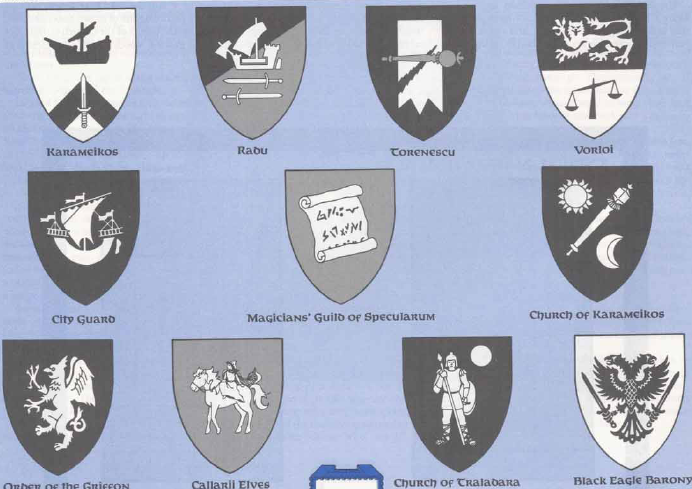
dual-wielding eagle, damn
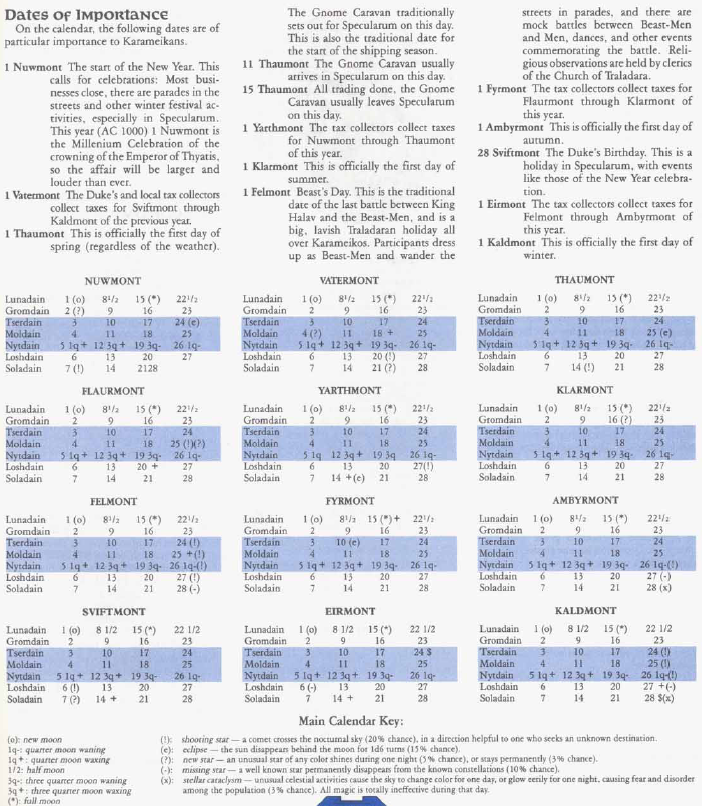
Note the 20% chance of a shooting star to guide the party
also comes my favorite note: A detailed economic overview of Karameikos, which incidentally notes that the reason there's so much Gold and Siver floating around in D&D is because there's more Gold and Silver on the D&D planet than on Earth and it's worth less as a result, but Gold and Silver are really cool anyway. Hah. It also has this:
quote:
While the above structures are handy to know in order to answer questions, they mean very little from a game perspective.
Useless Economics! And then it launches in a section on how players might engage in tax fraud and how the tax man fights back.
I'm telling ya: This series really understands how D&D is played.
Next Time: The Lay of the Land, Characters and Adventures
Gaz 1 Part 4: The Lay of the Land, Characters and Adventures
Original SA post
Gaz 1 Part 4: The Lay of the Land, Characters and Adventures
This next section of Karameikos is all about the land. It goes over the landscape itself, the resources availabe in many places (which are also adventure hooks - many ventures in the mountains fail due to tribes there, but the successful mines are very rich), the waterways and even "innumerable caverns" which are the perfect spot for lost civilizations, tribes of monsters, ancient horrors and hideouts for bandits. Every single section is laser-focused on being useful or inspirational for play, with notes on adding to it as required.
An Array of Strange Places
Then it launches into a description of the cities of Karameikos. It starts with Specularum, and it turns out that the official census of 50.000 was taken 15 years ago, and it's grown considerably since then. It's also very... well, medieval. Earthen narrow roads, crowds everywhere, the "sanitation" deserves its quotes, the lot. There's a map provided with the book, but there's not a lot of point showing it to you since I'm just skimming: this is just an overview of the various districts and what you can do there. Of especial note is The Nest, which is like the Shades of Ankh-Morpork: you go there and you're essentially committing suicide. A perfect place to send adventurers. It even comes with floor maps of "a Tavern" for when your PCs get into a fight in one of the many local holes.
The other notable places in Karameikos get their own descriptions. Some merit only a paragraph (included because they were mentioned in some adventure published before the GAZ was or just to introduce a neat NPC later). Some are more like the Black Eagle Barony. I'll go over the highlights.
Fort Doom
In Fort Doom, the Duke's Law is not followed at all, and the Baron's law rules all. And all crimes agaisnt the Baron (decided on whims, mostly) are punishable by death unless he's feeling okay that morning. Have I mentioned that Baron Von Hendrik's alignment is Chaotic? They really went all out to show what kind of place a Chaotic person with a mean streak rules. But that's not the limit of his villainy. Every single family is required to leave one hostage with the Guards, because they're mostly a community of fishermen. If a fisherman sails away, the hostage is killed. On top of that, said hostages are then soetimes indoctrinated into the Guard, whose main occupation is tormenting the locals. Monsters are hired into the guard and are allowed to roam the streets freely because they swore to fight for the Baron. You can just feel the misery radiating off these people.
Also in these lands is a wizard. A very special wizard. His name is Bargle the Infamous. And Fuck That Guy.
Today this name might not provoke a reaction from you, but if you ever played the Basic set solo adventure, you will know Bargle. Bargle the heinous, Bargle the murderer, Bargle who killed your adventuring companion, Aleena the cleric, while laughing at you because he felt like it, and who might also have stolen your shit. Bargle who got away with it . The adventure even provided a special spot on your character sheet where you could write Bargle down as your enemy. There's been more than one player over the years who has sworn eternal revenge upon Bargle.
Bargle is the Baron's court magician. Great move, Aaron Allston.
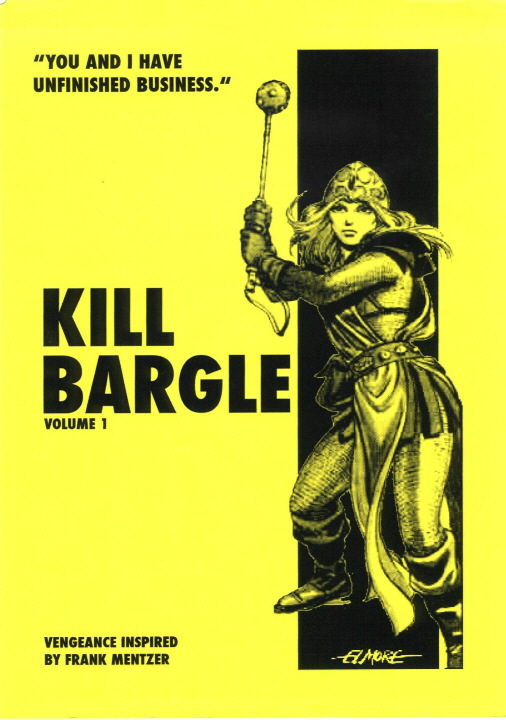
I am not even joking.
Marilenev
This fishing village which bears the former capital's name is only notable for the monstrously gothic castle that squats over it, presided over by a lonely widow who may be completely bugfuck insane named Lade Magda Marilenev. She used to be married to the ruler of Marilenev, who along with most of his family was slaughtered in the brief uprising when the Duke took over. If you want to portray the Duchy's less happy history, here's your place.
Sulescu
Wheras Marilenev just feels like it's ruled by a vampire, this vilage actually is. It's ruled by a nosferatu (distinct from normal D&D vampires in that it actually feeds on blood - no, really) and he can walk around in sunlight. He's also not that bad. He's essentially faked his entire family line to keep ruling, but the villagers don't accept him.
Threshold
This is the town most likely to be a base of operations for early adventurers in Karameikos. It's bordered on all sides by wilderness, it's fairly central and it's ruled by a cleric who can cast Raise Dead, all very important things as I'm sure you'll agree. Notably, no magic user may cast spells within the walls. The punishment is being inflicted with a Curse. It's also where the Patriarch's daughter Aleena lives... assuming she wasn't killed by Bargle during your solo adventure. Really. It's also much bigger than you'd expect, because the Baron decreed that no house may be built within 50 feet of another. What, you think only chaotic barons can issue some odd commands?
It's full of adventure opportunities, such as being host to one of the royal mints (secreted away so that Baron Von Hendriks won't find it and with its treasure guarded by Elves) and the ruins of an old wood mill that need to be cleared of repeated unexplained infestations of giant insects.
Strange Sites
A lot of these are here because they were included in previously published adventures, such as B10 Night's Dark Terror and B3 Palace of the Silver Princess. The most notable of these locations is a place called Haven, which was created by Halav, Petra and Zirchev... after their ascension to Immortality! Yes, they are essentially gods now. Their valley is almost completely cut off from the outside, and only opened in dire need. If you want to know what that dire need is, you need to buy and run B3. Clever.
It also includes a new location, Koryszegi Keep, complete with a set of maps. Nothing is in the ruins unless you put it there: it's just a fill-in-the-blanks adventure location. You don't see a lot of those anymore, but Basic loved them.
A Cast of Colourful Characters
NPCs. Dozens of them. Yeah, I'm going to be skimming this section too.
They're roughly classified by allegience or role, so naturally we start with the Royal Family.
Duke Stefan is the bigwig, as if you didn't know that by now. He is candid, uncompromising and the classic emotionally underwhelming manly man. He is fair, just and essentially a good man. However, he is completely at a loss when it comes to understanding the motivations behind Baron von Hendriks. He just can't comprehend evil, and is therefore unable to predict it or counter it easily or to form a consistent and coherent plan to fight it. He irrationally hoped that his cousing Von Hendriks was just going through a phase and would see the error of his ways once he saw the pain he inflicted, but it hasn't happened and now Stefan is at a loss for ideas. He can't just plunge his nascent country into civil war against one of his own vassals and thus compromise everything he's worked for! And in the meantime, the Black Eagle Barony gnaws away at the seams of his kingdom.
Deep.
He is married to Duchess Olivia , self-appointed spy mistress of Karameikos and, well, caring (if not necessarily loving) wife. The marriage was arranged, but they're both content. She's actually a more natural ruler than her husband, who is all charisma but has his faults in actual matters of policy. She often takes matters in her own hands and is proud to be able to raise a family outside normal Thyatian social standards, all free and passionate.
Their three children are Lady Adriana (a firebrand who doesn't take after her mother at all despite Olivia's attempts, who spent her Shearing as a Town Guardsman and also the favorite to be the heir to the throne), Lord Justin (a passionate but quiet man who spent his shearing trader and merchant and who doesn't enjoy court life at all) and Lord Valen (A boy who has just recently asked to be Sheared and is expected to be targeted by basically all the Duke's political enemies and the local criminal organizations while so cut off from the family. You can play him if you like or adventure with him as a low-level Thief NPC.)
So many people complain about Lady Adriana being the heir. She's a woman! It's medieval times! the GAZ series kindly tells them to sit down, be quiet and not spoil people's fun with pointless realism. This is the eighties and it's more progressive than many games are today.
Then comes a series of ministers. They all give you different kinds of jobs, such as exploring and guarding trade lanes and so on, but the most interesting dude is Admiral Lucius Hyraksos , Minister of War. He oversaw the construction of all the forts in the land. He commands the navy. And he's looking for a replacement, who can explicitly be one of the player characters. If one of the players don't get the position, his replacement could be... less good.
The second notable minister is Lord Valdo Tisza , minister of fincance, the only Traladaran minister in the cabinet and frequent traitor to the throne. He passes sensitive information to powerful Traladaran families in order to increase their prosperity and importance in the realm, which I suppose is a good intention is several of those families weren't basically the Mafia. It's only a matter of time before he's discovered, and it could end up poisoning Thyatian/Traladaran relations. His adventure hook is being tasked with giving the PCs the job of discovering who is passing information to local Traladaran families. Yikes!
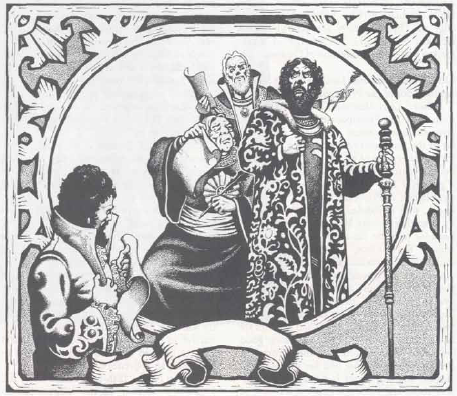
Stefan performs his royal duties
Ambassadors
These are a damn colourful bunch, mostly minor nobles or people of small importance who got saddled with being the ambassadors to a half-formed kingdom. The big exception to this is Lord Cornel Osteric , embassador of the Empire of Thyatis, here to report back to the Emperor and to make sure Thyatis continues to receive better trade than Ierendi and Minrothad. This is actually a somewhat important post in Thyatian terms, and he exploits it ruthlessly. He is also really petty, and I'll just let the text say it.
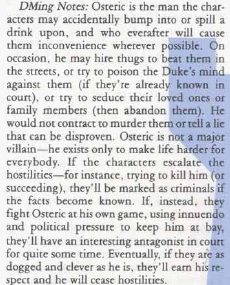
The fun of this dude depends a lot on the campaign and the players, but it's a neat idea.
The other big fun Ambassador NPC who isn't just there so PCs can ask questions about Foreign Lands is Doña (Lady) Marianita Lucia Di Leon y Valdez , Ambassador of the Principalities of Glantri. Unfortunately she does fall into the "tempestuous" ethnic stereotype, but she does it in an interesting way by being the most poweful magic user in Karameikos. She got into a tryst with an Elf lord in Glantri who was being pursued by a more powerful rival, who complained to Princess Carnelia of Glantri, who solved the situation by sending Marianita to be an ambassador to some podunk place Glantri doesn't even do business with.
Neither one counted on Marianita quite enjoying being literally the most powerful wizard in the land she's in, as well as being considered one of the most beautiful, intelligent and interesting women in the court with the most exotic, sophisticated and daring sense of fashion. She's a hedonist but is very serious about magic and doesn't abuse it - at most she'll slam a door behind her and wizard lock it when she's annoyed with you. She also flirts with the Duke and his eldest son just to get under the duchess' skin, adores the Alfheim ambassador Shalander and detests the one from the Emirates of Ylaruam, among other social connections. If you have a court adventure in Karameikos, this ambassador will feature prominently. And she's not the worst ethnic stereotype either.
Shalander is the Alfheim ambassador, and is an Elf. He used to be all adventurous but has settled a little bit (although it's noted that he's still merry and fond of frolicking, because this is the eighties and this is an elf). He's come to enjoy human politics in terms of likening them to territorial animals who fight and turn on each other. He's also fond of human women for similar nature-based reasons. There's also ambassadors of the Halflings, Gnomes and Dwarves, but they're all very similar: stereotypical for their race and mostly there so PCs can ask them about their homelands.
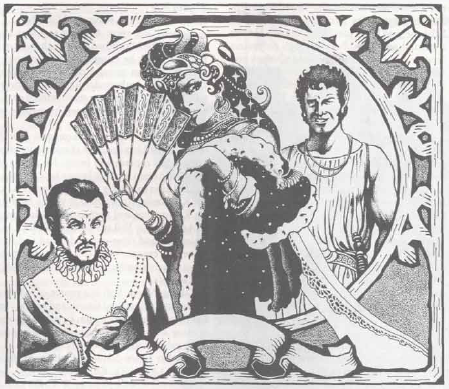
Lord Osteric, Lady di Leon y Valdez and
Then come Gunther Schonberg , an "everybody's uncle" kind of dude and former Thyatian mercenary who also fought for Ylaruam who nonetheless is now the ambassador of Ierendi because no Ierendi would have not abused the position for their clan, and Aladan Voll of the Minrothad Guilds who... is an old sea dog. And that's it. This was early in the product line, so they hadn't quite settled on what the Minrothad guilds or Ierendi were, so.
And then comes our winner of Worst Ethnic Stereotype for this supplement: Sheik Abdalla ibn Hamid , of the Emirates of Ylaruam. He is so Arabic you could shake him and get a nice beach to lie on. His voice sounds lyrical. He is a "desert nomad-warrior". He is impressed only by three things: Great honor, great prowess, and great beauty, and he sees himself as a "desert wolf surrounded by sheep" in Karameikos. And oh yes, he plans to kidnap the Glantrian ambassador to make her part of his personal harem, courting her "with all the good grace of a desert camel".
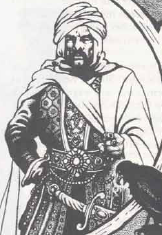
He is so Arabic that everything about him is prefixed with "desert".
The "11th level fighter successfully kidnaps and contains an 18th level Magic User" thing is his primary plot hook. For some reason it's expected that a woman who can charm, dominate and burn Abdallah to a crisp with eigth level spells will need rescuing. Plus with her stereotype clashing against his it sounds more like a B-grade romantic comedy.
The Clergy of Karameikos
I'm almost glad to move on to religion after that last dude. We start with Lord Olliver Jowett , Patriarch of Specularum and the Church of Karameikos and Master of the Order of the Griffon. You know he's a big deal because his title is longer than the Duke's. Fortunately, he's also gentle and good-natured old man who just wants everyone to get along in good health and prosperity. He's also not a zealot, and trusts his church's teachings to be convincing enough rather than for it to be a One True Way. He's also keeping the lid on burgeoning schisms in his church but, alas, he is old. If he becomes ill or dies, the church splits into terrible internal strife for reasons that are about to become clear.
Alfric Oderbry is that reason. He is an immense racist, and considers Traladarans to be worth less than what clings to his boots. He wants to see the natives crushed so that Thyatians can take their "natural place" in Karameikos. His old mentor, a bitter old man who lost considerable wealth in the land debacle some twenty-thirty years earlier, taught his pupil all about how the Duke was too weak to crush the Traladarans, how that weakling Olliver propped him up, and so on. If only someone strong could take over and lead the church... and so that's what Alfric has been working towards. He's hidden his intentions for two decades and is now close to being one of the most powerful people in the Karameikan church.
Should he gain power on Olliver's death or illness, he intends to turn the Order of the Griffon on all his enemies, which is everyone who doesn't think like him and isn't Thyatian, and to pressure the duke into making the Church of Traladara illegal. A fun dude! He is noted to be the source of several adventures all by himself thanks to his ambitions.
Olliver's counterpart in the Traladaran church is Aleksyev Nikelnevich. He once bitterly resented the Thyatians, but through his clerical studies, religious meditation and friendship with Olliver Jolwett he has forgiven all involved and now seeks to rather make sure that such violence does not occur again and to direct Karameikos to a new Golden Age through peace and shared faith. Other than that, he primarily exists as a foil for Alfric should war break out and is theoretically in charge of all player character Clerics of Traladara in such a crisis.
And then there's the third religious arm, the Cult of Halav, led by Sergyev. He has no other name. He is insane. He used to be a member of the Church of Traladara but, well. He spends most of his time stalking and worshipping the royal family, and getting in the PCs' way whenever it is most inconvenient.
The Concerned Citizens
This section largely introduces "colour" NPCs, such as a playwright who is secretly in the employ of the duchess, a "homeless" man who is actually rather well off and married, and some boring people who mostly exist to give quests. But in between them lurk crime bosses and murderers!
Starting with Flameflicker . She is the local Robin Hood figure. She so well conceals her identity that most people think she's male. Her cover identity is as Alya, a Traladaran palm reader and fortune teller. She mostly sticks to planning heists, though a particuarly exciting opportunity might draw her out.
There's Teldon , who is... well, he's a stereotypical old wizard who embroiders his stuff with fake runes and acts more senile than he is. if you compare the contents of his spellbook to the spells you can learn in Karameikos, you'll note that they're identical. That's because he basically is the local magician's guild. He's still not as powerful as the Glantrian ambassador, and the Glantrian ambassador isn't even unusually powerful for Glantri nobility, so that should tell you something about that place before we visit it.
Then there's the Torenescu, Radu and Vorloi clans. They're an intricately connected bunch of merchants and mafiosos who engage in constant scheming with one another, and are best left for anyone reading this to discover should they wish to. This post will be long enough anyway!
And on a final note, there's one curious NPC: Yolanda of Luln. She has one driving ambition: Destroy the Black Eagle Barony. Her tools; Song and dance. She is the highest paid entertainer in Specularum, and the bulk of it goes either to her mother in Luln (who is angling for Ladyship there - you might recall this from the location overview!) and to bribe various officials to keep up the pressure on the Duke to do something about his cousin. If she catches wind of the PCs making a move against the Black Barony, she'll supply them as best she can.
The Rest of the Duchy
Most of the rest of the chapter is devoted to quest-giving NPCs of some stripe in the various towns which I don't really need to detail: they're all interesting, but there's only so much I can cover! That is, until we suddenly get to learn more about von Hendriks.
Baron Ludwig Von Hendriks is completely evil. He is cousing to Stefan and some of his more successful ministers, and has always been jealous of them. Stefan was supposed to die during his military ventures and leave everything to Ludwig, but then Stefan gave his lands away and travelled to the arse end of nowhere instead! He seized the opportunity to conquer some land of his own and now plots relentlessly to kill the Duke and take his lands. He is oily, arrogant, short-tempered, a casual killer but with a fondness for torture. He'll make and break any bargain, no matter how vile.
Now this is a villain.
His court magician is Bargle. In addition to being Bargle and therefore a twelve-year-old's worst imaginary enemy, he is also the enthusiastic man in control of the Iron Ring slavers. He wiggled his way into apprenticeship by killing another apprentice, stealing his magical equipment and then posing as an apprentice elsewhere who had lost his master. He then proceeded to pass from master to master, sometimes with bodies in his wake. He will gladly use his power to be a petty and cruel tyrant who enjoys inflicting pain for its own sake, and particularly enjoys magically charming people into becoming his pawns and sends them to their deaths.
Basically, fuck that guy.

Those Fuckers (not pictured: Our Shit)
Adventures
The final section of the book details potential plots you can cook up. They range from a war among thieves (with a PC involved after getting romantic with Alya/Flameflicker), the inevitable war between the churches (even if a PC becomes a patriarch instead of Alfric), the search for a successor for the Admiral, and Baron Ludwig von Hendriks being Jigsaw from the Saw movies.
No, seriously!
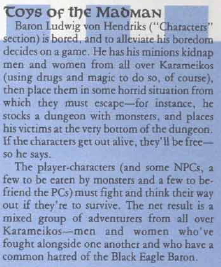
There is advice for where the adventurers are appropriate, how to adjust them, how powerful the characters should be (measured by which set they're up to in levels), and a section on adventures already in print which you might check out for more! All in all, a good book for... wait, that was only 64 pages ? Holy shit.
Conclusion
All in all, a rousing start for the series! Some of it can be forgiven just for the time it was published, some of it is more progressive than people today want to be, and a bit of it is a little dated in other ways, but for 64 pages this is one of the densest, most useful books on running yourself some D&D you could possibly hope to find. Even the "DM's history" section with its secret "real" history of Karameikos can be forgiven because it involves spoilers for a contemporary published adventure, although this is poorly explained. I highly recommend that any D&D player pick up and read this book at least once.
But I'll be honest: I don't like the next Gazetteer nearly as much. If you think that Sheik Abdallah was a bit much, just wait until...
Next Time: Gazetteer 2, The Emirates of Ylaruam